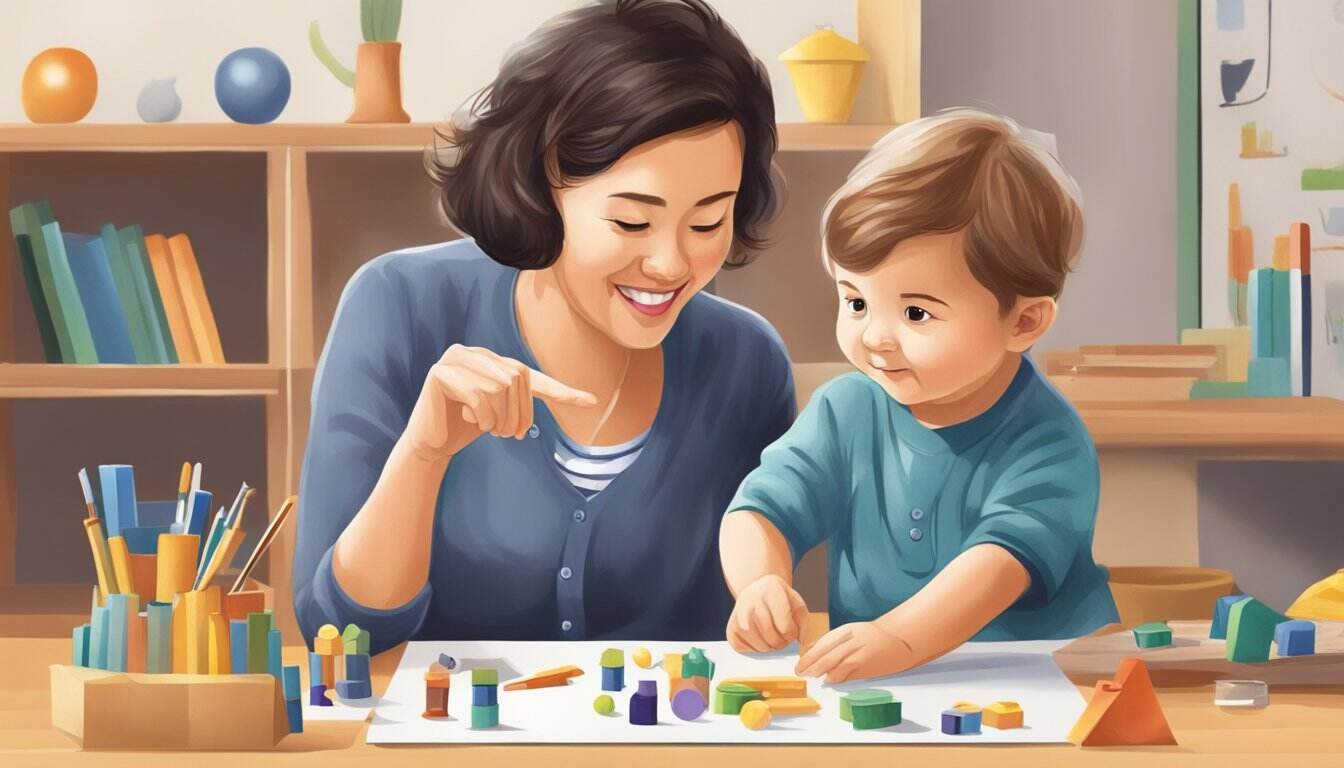Many kids who have trouble with language find it hard to use the past tense of verbs. They might mix up times, using present tense for past events. Or they could change the words in a way that’s not quite right. This makes it tricky to know if they’re talking about the past or present. Teaching them the past simple tense is key for English language learners. It helps them describe things that have already happened. With fun and engaging activities, relatable examples, and interactive lessons, teachers can make learning about the past simple tense fun and easy.
Key Takeaways
- Many children struggle with using the past tense of verbs correctly.
- Teaching the past simple tense is crucial for English language learners.
- Engaging activities, relatable examples, and interactive lessons can help kids understand the past simple tense easily.
- Educators should focus on making the grammar concept relevant and memorable for students.
- Incorporating fun and creative teaching methods can enhance the learning experience.
Understand the Concept of Past Tense
Before diving into the past simple tense, it’s key for students to get the idea. Start by showing a timeline. Have “Today” in the middle and words like “yesterday,” “last week,” and “last year” on each side. Tell them past tense is for things that already happened.
Draw a Timeline
A timeline is a great tool for making grammar easier to understand. It shows time clearly. Put a simple timeline with common past tense references. This makes the past tense easier and more fun for kids to learn.
Explain Past Events
After they get what the past tense means, move on to talking about past events. Show fun past tense examples. Then, let students share their own stories using the past tense. This teaching method makes lessons interesting and helps kids relate to the grammar.
Teach Regular Past Tense Verbs
After learning about the past tense, it’s time for the past simple form of regular verbs. Choose a regular verb and show a present tense sentence. Then, change it to past simple by adding “-ed”. For example, “I play” becomes “I played”. This way, you help students learn how to switch regular verbs to past simple tense. Be sure to give many examples for them to practice.
Introduce the -ed Ending
Tell your students that to make the past simple form of a regular verb, they add “-ed”. It’s a rule that makes it easy to change present verbs to past. Use examples like “walk” to “walked”, “play” to “played”, and “jump” to “jumped”. Then, ask them to create past tense sentences to practice.
Practice with Before and After Pictures
A fun way to teach past simple verbs is with before and after pictures. It shows a visual of events in the past. First, show a picture of present action, then its completion in the past. Then, have them use past simple tense to describe the action. For instance, they can say “The girl jumped over the fence” or “The boy painted the wall.”
Engage with Actions and Storytelling
Another great way to learn the past simple is by acting out and describing the events with past tense verbs. Ask students to physically do an action, then say what they did in the past tense. For instance, after they walk, they can say “I walked across the room”. This method makes the grammar point more fun and relatable for kids.
How to explain past simple to kids?
To teach kids the past simple tense, use relatable examples. Encourage them to retell past events. Begin with things they did yesterday or last weekend. This way, they see how it fits their daily life. It becomes more understandable and meaningful to them. After they get the idea, let them have a go at recalling past events. They can talk about their own memories or stories you’ve read together. Doing this makes using past simple verbs clear and engaging.
Use Relatable Examples
Start your lessons with examples they know and live daily. Ask about their last weekend or what was yesterday at school. Connecting grammar to their life makes it fun and realistic for them. It aids in the learning process.
Encourage Retelling Past Events
Once they understand the past simple tense structure, push them to practice retelling past events. Use storytelling exercises. You tell a story, they talk about what happened long ago. They can also add their own experiences. Like what they did yesterday or last summer. These steps make using past simple verbs come naturally during conversations.
Introduce Irregular Past Tense Verbs

After teaching regular past simple verbs, it’s time for the irregular ones. Irregular verbs don’t follow the regular rules. They need to be memorized. It may be tougher, but the right method makes it fun and memorable.
Explain Irregular Verb Rules
Write a present simple sentence with an irregular verb on the board first. Then, have students guess its past tense. Share the correct form. Explain that irregular verbs have their own rules and variations. They don’t end in “-ed”.
Point out that students should learn these words one by one. However, there are some things they tend to share. It’s not all just memorizing, sometimes they’ll see a pattern.
Provide Common Irregular Verb Lists
Give students a list of the most used irregular verbs. Include both their present and past forms. Ask them to use these verbs in sentences and fun activities like storytelling. This makes the irregular verbs more real and helps students use them correctly.
| Present Tense | Past Tense |
|---|---|
| be | was/were |
| have | had |
| go | went |
| see | saw |
| do | did |
| say | said |
| make | made |
| come | came |
Practice Past Tense Negatives and Questions
After mastering regular and irregular past verbs, it’s time for the negative and question forms. To teach about the negative form, tell students they should add “did not” before the verb. Give examples and let them create their own negative sentences.
Model Interrogative Sentences
To show interrogative form, use “did” for questions. Then, have students practice asking each other questions in the past simple. This gets them using past tense when talking about past events and adventures.
Engage in Conversational Practice
Chatting with students helps them really get the hang of past simple. Tell them to talk about their own past or past events. This hands-on method helps young learners connect with and remember grammar rules.
Reinforce with Fun Activities
To make learning the past simple tense fun, use engaging activities in your teaching. Try grammar games, interactive worksheets, and storytelling. These methods help kids enjoy and remember how to use past simple tense.
Play Grammar Games
Board games and self-made games get students using past simple verbs. These games are fun but also competitive. They help students practice and solidify their past tense usage.
Use Interactive Worksheets
Worksheets that are hands-on, with fill-in-the-blank or matching activities, are also great. They let students directly apply what they’ve learned. This gives them quick feedback on how well they understand the grammar.
Tell Stories Using Past Tense
Ask students to share stories in the past simple tense. They can talk about their own experiences or use your prompts. This helps them apply what they’ve learned in a creative way. It also shows how well they can use past tense verbs.
Conclusion
Teaching kids the past simple tense can be both fun and rewarding. It’s great when you use methods that are engaging and relatable. Beginning with the basic ideas, like what the past tense is, goes a long way.
You start by showing regular and irregular action words. Then, you move on to how to make sentences negative or question them. Mixing in fun activities makes learning stick.
Remember, patience and creativity are key. They help make lessons that really mean something to your students. The goal is for them to feel confident when talking about their own experiences.
It’s all about keeping things interactive. This way, past tense lessons become both relevant and memorable for kids. By using these strategies, they’ll not only learn the past simple well but also grow to love English and its stories.
So, let’s take on the challenge of teaching the past simple tense with joy. This will lead to amazing learning adventures for our students.
FAQ
How can I explain the past simple tense to kids?
To explain the past simple tense to kids, start by using a timeline to show past events. Show how regular past tense verbs end in “-ed”. Use fun activities, like comparing before and after pictures. This makes learning the past simple tense practical and enjoyable.
What are some tips for teaching regular past tense verbs?
Teaching regular past tense verbs begins with present simple sentences. Show kids how to change these by adding “-ed” for the past. Then, let them practice by acting out and telling stories about past events. This method makes learning verbs fun and easy.
How can I make the past simple tense more engaging for kids?
Make the past simple tense fun by using examples from kids’ own lives. Encourage them to talk about what already happened. Mix in grammar games, interactive sheets, and story activities. This approach helps kids remember and enjoy learning the past simple tense.
How do I introduce irregular past tense verbs?
Start with explaining irregular past tense verbs to kids. They don’t follow the regular “-ed” rule and need to be memorized. Share some examples of irregular verbs. Then, teach common ones and have students use them in sentences and games. This makes learning irregular verbs fun and interactive.
What are some effective ways to practice the past simple tense with kids?
For practicing the past simple tense, use games, worksheets, and stories. These activities make kids more confident talking about past experiences using the past simple tense. It’s a fun and practical way to reinforce their learning.





